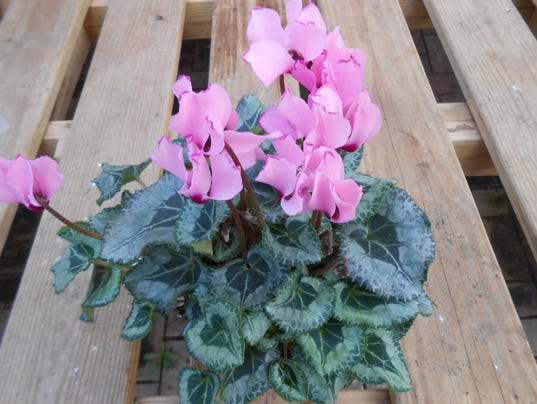If you are looking for a plant to enhance your decorations or give as a gift and you want to avoid the usual poinsettias, you might consider a cyclamen.
Cyclamen persicum is the plant you will find in florist’s shops or garden centers. The plant is a native of the Mediterranean area and its bloom cycle reflects that heritage. The growers who supply cyclamen cultivate them from seed; however, that is a process both lengthy and difficult so most purchase a plant that is already flourishing from its tuber. The flowers have swept back petals in red, pink and white varieties. Care of a cyclamen is a little bit tricky but the rewards are worth it.
Cyclamen begin blooming in the fall when temperatures start to cool. Keeping the plant at the right temperature is part of the tricky part. The preferred temperatures are between 40 and 60 degrees so that is a little cooler than most of our room temperatures.
Thus, placement near a south, east or west window will satisfy both the need for light and a slightly cooler temperature. The plant will usually bloom for about two months. During that period carefully monitor how you water. Cyclamen do not like soggy soil. If the pot feels lightweight or the plant begins to droop, water thoroughly and allow to drain. Don’t leave the pot standing in water and let the soil become somewhat dry before watering again.
During the bloom period, keep finished blossoms and yellowing leaves cut off at the base. After a lengthy period of bloom – probably in early spring – the cyclamen will become dormant. Many owners assume that they somehow mistreated the plant and will toss it out. But remember that is the regular and expected growth cycle. The plant will continue to rest during the warm summer months and can benefit from being placed outdoors in a shady spot with reduced watering and feeding. In the fall – maybe September – bring the plant back indoors and water thoroughly. Watch for new growth to begin. If it doesn’t, try watering again but don’t let it stay wet or the tuber will rot (think of how you manage iris).
Cyclamen has few pests or disease problems. The plant has thrived in European areas for many hundreds of years and was regarded as the flower of love. Before cyclamen began to be popular at Christmas, it was frequently given at Valentine’s Day because of the reputation of inspiring love. It was sometimes called the Virgin’s Plant because the red dot in the center of the blossom represented the lingering sorrow in Mary’s heart at the loss of her son.
The name was derived from a Greek word for circle because of the shape of the tuber. Whatever plant you may choose for decoration or gifting, the scent and sight of living plants perks up the often dreary winter days. If you opt for cyclamen, enjoy the lengthy bloom time and work for success in reblooming.
[“Source-newarkadvocate”]











